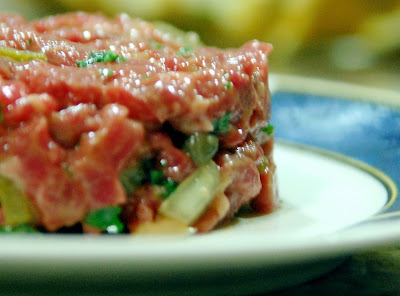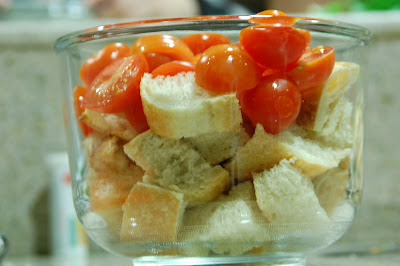 By the time I got to my apartment in Paris, sans checked luggage (which was in Austria if you were curious), jetlagged and suddenly very homesick for my friends, I immediately wandered out into my new neighborhood in search of something comforting. I already knew what I wanted, and it was not difficult to find.
By the time I got to my apartment in Paris, sans checked luggage (which was in Austria if you were curious), jetlagged and suddenly very homesick for my friends, I immediately wandered out into my new neighborhood in search of something comforting. I already knew what I wanted, and it was not difficult to find.French onion soup made correctly is dark brown and rich with the slow-cooked sugars that onions release when cooked for a long period of time. Onions have been around, cheap and easy to grow, and a staple of most world cuisines for a long period of time, so fairly early on someone decided to make soup out of them. What's also been around for a really long time? Bread. What else? Cheese. Also, ovens. Finito. Observations about this dish:
-It is the only dish I know of that tells you not to worry about burning the onions in the pot, just leave them alone.
-It was Julia Child’s last meal
-People are typically very impressed when one makes it from scratch, especially when you have all that time to entertain them since you don’t have to worry about the onions.
So make it from scratch, like all weensy little bistros in France take such pride in doing, though probably not with weary Frenglish-spouting students abroad in mind. You know what the French think? It wasn’t some Roman peasant who composed the first draft of this universally pleasing classic, driven by tyranny, poverty and hunger. It was big fat old Louis XV who found nothing in the food stores of his hunting lodge but onions, butter, and champagne (could you be any more French?) and threw them together thinking that three beautiful things could never make one beautiful soup. Well, the French, if you didn’t make the best damn onion soup in the world, I’d boycott it. But because it's so good, I've decided to make it in honor of the several thousandth or so birthday of this dish.
5 onions. Take your pick- sweet onions like Vidalias are nice, but mix it up.
4 tablespoons of butter
1 large box each of chicken and beef stock
1/2 bottle of white wine
large bunch of flat-leaf parsley
a bouquet garni
loaf of good quality white bread (like for bread and burrata salad)
giant mountain of shredded gruyere, swiss, or any other kind of good melting cheese
Peel, top 'n tail, halve, and thinly slice your onions. Don't let those little devils intimidate you, their invisible but potent sulfenic acid cloud can be avoided by slicing them under running water, or sticking them in the freezer for 15 or 20 minutes beforehand. Personally, I cry. It's a good hurt.

Heat up the butter in a large saucepan until it begins to foam, then add what will appear at first to be a considerable amount of onions, along with a teaspoon of salt.


Without stirring, let the onions cook on medium heat for 15 to 20 minutes, or until they're golden brown, then stir so that the onions on the top are now on the bottom and repeat. Cook on very low heat for another hour, making sure none of them are burning.
"Sad but true" fact: if you don't cook the onions for the soup all the way through, the fumes from the uncooked portion may exit through your pores for a solid couple of days. They're ready when they're totally limp and falling apart, no crunch to them whatsoever.
Add on top of the cooked onions your very own bouquet garni, which I'm going to translate as "bunch of herbs tied together and tossed in the pot of French food you're clearly making." If you find yourself completely out of kitchen twine (white string), use the herb itself. This makes it easier to fish out at the end. I tied together a bunch of fresh rosemary with parsley and it held together quite nicely.

Add the wine, 2/3 of the box of beef stock and 1/3 of the box of chicken. This ratio mellows out the frequently overpowering flavor of many canned and boxed beef broths.

The soup will look like this. Notice the sheen. That's how you know the onion fairy's been there.

Bring it up to a medium simmer and cook for another half hour or so. Preheat the oven to 375.
Cut the loaf of bread into 1/2-inch to 1-inch slices. Arrange artistically.

The size of the bowl and the shape of the bread will determine how many croutons go in, so try to estimate before you toast them (they'll shrink a little). They should fit snugly to the edges.


When that's done, grate a mountain of cheese. Since I was celebrating a French thing's birthday, I used real gruyere. It made a difference. I've also had it with swiss, raclette, fontina, and even mozzarella, but gruyere has a sharp taste that contrasts well with the smooth, sweet flavor of the onion broth and crisps up beautifully under a broiler. If you have some left over, make a French omelette for breakfast with a little green salad and glass of beer. Why the alcohol with breakfast? Because of the gruyere. Okay, we're clear on that.

Locate and remove the bouquet garni and any loose herbs. Ladle soup into a crockpot to the 2/3 full mark, then add your pre-sized croutons.

They should be submerged in the broth, but make sure you leave the tops dry.
Layer the cheese thickly on top of the crouton and bake for 10-15 minutes, or until cheese is completely melted.


Remove crock pots carefully and crank up the oven to broil. It'll take five to ten minutes. Return to oven and broil until cheese turns golden brown, about 3 minutes. The bake and broil technique results in a chewier top. If you're going for crunchy, omit the baking part and just broil the cheese.

Puncture with a spoon and eat from the inside out.

Receive much praise.











































